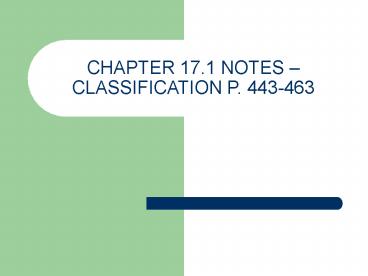CHAPTER 17.1 NOTES - PowerPoint PPT Presentation
1 / 16
Title:
CHAPTER 17.1 NOTES
Description:
CHAPTER 17.1 NOTES CLASSIFICATION P. 443-463 I. What is classification? ___Classification_____ - the grouping of objects or information based on similarities. – PowerPoint PPT presentation
Number of Views:125
Avg rating:3.0/5.0
Title: CHAPTER 17.1 NOTES
1
CHAPTER 17.1 NOTES CLASSIFICATION P. 443-463
2
I. What is classification?
- ___Classification______ - the grouping of objects
or information based on similarities. - ___Taxonomy______ the branch of biology that
groups and names organisms based on studies of
their different characteristics.
3
II. Why do scientists classify?
- To better understand and study the enormous
variety of living things.
4
III. How does the classification system work?
- Based on a system developed by Carolus
___Linnaeus___ - He established a system of groups called
___Taxa_____. (plural taxons) - He ranked taxa from the ____largest_____, most
general groups to the ____smallest______, most
specific groups.
5
A. THE LEVELS ARE
- Most__ General ? KINGDOM
- PHYLUM
- CLASS
- ORDER
- FAMILY
- GENUS
- Most___ Specific ? SPECIES
6
K P C O F G S
- King Kingdom
- Phillip Phylum
- Came Class
- Over Order
- For Family
- Green Genus
- Soup Species
7
- At each level, organisms that share the most
characteristics are grouped. - _____Species_____ is the most specific. (members
of the same species can produce offspring) - _____Kingdom_____ is the most general.
- Note The Plant Kingdom Is Divided
Into__Division___ - Rather Than Phyla.
8
B. NAMING AN ORGANISM
- Crawdad, Crayfish, Mudbug ? What Is The
Difference? - Linnaeus proposed a system of naming using 2
names this system is called____binomial
nomenclature_______. - Linnaeus used _____Latin_______words to describe
names of organisms.
9
The 2 names for each organism are
- ___Genus_____ - always first and capitalized
can be abbreviated to 1 letter. - ___Species_____ - second and lowercase
- both are underlined or italicized.
- Example Homo sapiens, Canis familiaris or
Streptococcus pneumonia
10
___Dichotomous Key____ - a tool used for
identifying organisms.
- Lists specific observable traits of many
organisms. - For each trait, the key lists two contrasting
options. - By picking the options that match an organisms
features, you can identify the organism.
11
IV. How are evolutionary relationships
determined?
- ____Classification________ provides a framework
in which to study the relationships among living
and extinct species. - Organisms are put into ____groups____ based on
similarities of structure, behavior, chromosomes,
biochemistry, geographical distribution
12
1. Phylogeny the evolutionary history of a
species.
13
- How does the fanlike diagram differ from a
cladogram? - To which group are sea stars more closely
related, arthropods or jellyfishes? - Which group of
- animals includes
- the fewest species?
14
2. ____Cladogram_____ as organisms evolve from
a common ancestor they retain certain
characteristics.
15
1.What five probable ancestors of the modern bird
(robin) are shown on the cladogram?2.Which
dinosaur is probably the most recent common
ancestor of Velociraptor and Archaeopteryx?3.Whi
ch traits shown on the cladogram are shared by
Archaeopteryx and modern birds?
16
Works Cited
- The Swedish botanist Carolus Linnaeus
(1707-1778).. IRC. 2005. unitedstreaming. 24
January 2006 lthttp//www.unitedstreaming.com/gt































